Ammonia Volatilization from Wet Animal Manures - PowerPoint PPT Presentation
Title:
Ammonia Volatilization from Wet Animal Manures
Description:
Mattila (1998) - cattle slurry - 0 NH3v with injection; band broadcast. Sommer and Ersboll (1994) - cattle and swine slurry- NH3v from injected slurry ... – PowerPoint PPT presentation
Number of Views:85
Avg rating:3.0/5.0
Title: Ammonia Volatilization from Wet Animal Manures
1
Ammonia Volatilization from Wet Animal Manures
- C.W. Wood, J.J. Meisinger, P.A. Moore, Jr., and
R.B. Thompson - Auburn University, USDA-ARS, Beltsville, MD and
Fayetteville, AR
2
I. Problems With NH3 Volatilization
- Acid Atmospheric Deposition
- raises pH of rainwater, more SO2 dissolves
- ammonium sulfate forms - oxidizes soil
- releases sulfuric nitric acid
- Eutrophication
- water and land
- Loss of N to farmers
- Lowers NP
3
II. Sources of NH3 on Livestock Farms
- Manure Application
- Animal Housing
- Manure Storage
- Grazing
- Fertilizer Application
- Crops
Descending Order of Importance
Bussink Oenema, 1998
4
III. Nature and Handling
5
Loehr, 1974
6
(No Transcript)
7
(No Transcript)
8
Travelling Gun
9
Tank Spreaders
10
(No Transcript)
11
(No Transcript)
12
(No Transcript)
13
(No Transcript)
14
IV. Factors Affecting NH3 Volatilization From
Liquid Manures
- A. Time
15
Pig Slurry New Zealand 368 kg N/ha applied
15.5 of NH4-N
16
IV. Factors Affecting NH3 Volatilization From
Liquid Manures
- B. Those That Affect Transfer of Gas Between Soil
Solution and the Atmosphere
17
Solution/Atmosphere Interface
- Mattila (1998) - cattle slurry - 0 NH3v with
injection band lt broadcast - Sommer and Ersboll (1994) - cattle and swine
slurry- NH3v from injected slurry in tilled soil
was 30 of that from unworked soil harrowing
before surface application reduced NH3v by 50 - Sharpe Harper (1997) - swine effluent -13 of
TAN lost via spray drift, 69 more after settling
18
(No Transcript)
19
Solution/Atmosphere Interface
- Sommer et al. (1997) - pig slurry - trail hose
application resulted in 1/2 TAN loss of splash
plate application trail hose more effective
under large plant canopy and low solar radiation
20
Air Velocity
- Sommer et al. (1991) - cattle slurry
- NH3v rate increased to 2.5 m/sec no change
between 2.5 and 4 m/sec - crust formation with increased wind speed may
increase liquid phase resistance
21
Rainfall/Soil Moisture
- Beauchamp et al. (1982) - cattle slurry
- rainfall depressed volatilization temporarily
- difficult to distinguish from effect of
temperature (rainfall lower temperature) - may leach soluble ammoniacal N into soil
- Sommer et al. (1991) - cattle slurry
- frozen soil prevented infiltration
- NH3v rate low, but constant - 6-day cumulative
loss high
22
IV. Factors Affecting NH3 Volatilization From
Liquid Manures
- C. Those That Affect Rate of Chemical Reaction
23
ammoniacal N
24
Basic Chemistry
25
Swine Waste TAN
26
Cattle Waste TAN
27
Poultry Waste TAN
28
ammoniacal N
- Brunke et al. (1988) - surface applied swine and
dairy slurries - linear relationship between ammonia
volatilization and ammoniacal N - Frost (1994) - surface applied cattle slurry
- amount of dilution water added was linearly and
inversely related to volatilization - dilution of 0.9-1.21 waterslurry lowered
specific volatilization/unit slurry by 50
29
ammoniacal N
- Stevens et al. (1992) - surface applied cattle
slurry - 50 decrease with separation through 10-mm mesh
plus dilution with 86 by volume of water - 75 decrease with separation through 5-mm mesh
plus dilution with 100 by volume of water
30
Temperature
31
Micro-meteorological studies
- Two applications to arable land (corn stubble)
- April/May 97
- 38 m3 ha-1
- 51 kg NH4-N ha-1
- December 96
- 88 m3 ha-1
- 91 kg NH4-N ha-1
32
Ammonia Loss from Cattle Slurry applied 30 April
- rate 38 m3 ha-1,
- applied to corn stubble
- measured with MM
Total 8 day loss 71 of NH4-N
Rate NH3 loss (gN ha-1 hr-1)
Air temp
hours
33
Ammonia Loss from Cattle Slurry applied 5 December
- rate 88 m3 ha-1,
- applied to corn stubble
- measured with MM
Total loss 19 of NH4-N
26 mm RF
Rate NH3 loss (gN ha-1 hr-1)
11 mm RF
Air temp
hours
34
pH
35
AR swine manure 150 kg N/ha
36
AR swine manure 150 kg N/ha AlCl3 0-0.75v
37
AR swine manure 150 kg N/ha AlCl3 0-0.75v
38
Other Factors
- Soil CEC - minimum of 25 meq/100 g (Sharpe
Harper, 1995) - Soil pH
- Atmospheric NH3
- Plant absorption
39
Summary
- NH3 volatilization causes environmental problems
and economic losses to farmers - NH3 volatilization from liquid animal manures is
fast - Exposure to the soil surface enhances NH3
volatilization from liquid animal manures - Environmental factors have a large influence
- ammoniacal-N probably has the greatest
influence - Dilution and acidification can help control NH3
volatilization from surface applied wet animal
manures
40
Research Needs
- A coordinated research program is needed on NH3v
from wet manures that encompasses a wide range of
manures, weather conditions, and soil-tillage
systems. Databases developed from such a research
program would contribute to improved estimates of
NH3v and improved management techniques for wet
manures. - Research should include a continuum from source
to atmosphere.































